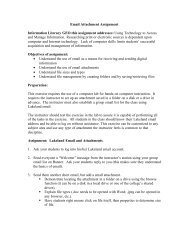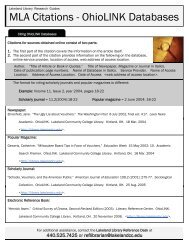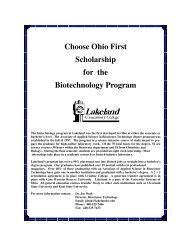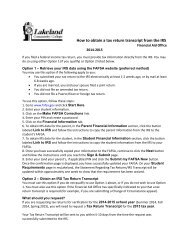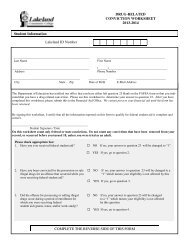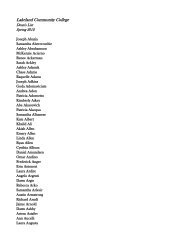1 BIOL 1510 Principles of Biology I Syllabus PREREQUISITES: none
1 BIOL 1510 Principles of Biology I Syllabus PREREQUISITES: none
1 BIOL 1510 Principles of Biology I Syllabus PREREQUISITES: none
Create successful ePaper yourself
Turn your PDF publications into a flip-book with our unique Google optimized e-Paper software.
<strong>BIOL</strong> <strong>1510</strong> <strong>Principles</strong> <strong>of</strong> <strong>Biology</strong> I<br />
<strong>Syllabus</strong><br />
<strong>PREREQUISITES</strong>: <strong>none</strong><br />
COURSE DESCRIPTION:<br />
This course introduces the student to the organization <strong>of</strong> living systems, energy transfer, continuity <strong>of</strong> life,<br />
biodiversity, and classification <strong>of</strong> living things. The topics include: biological history; structure and functions <strong>of</strong><br />
cells and cellular organelles; cell division; general biochemistry; cellular respiration; photosynthesis; DNA<br />
structure and function; protein synthesis; heredity; evolution; animal development; classification; and introductions<br />
to viruses, prokaryotes, Protista, and Fungi. This course has both a lecture and laboratory component. It<br />
provides the prerequisite for <strong>BIOL</strong> 1520 <strong>Principles</strong> <strong>of</strong> <strong>Biology</strong> II, and advanced courses in biology. This course<br />
and <strong>BIOL</strong> 1520 provide a general introduction to the biological sciences for the science major. ( 4 Credits; 6<br />
contact hours: 3 lecture, 3 lab)<br />
RATIONALE FOR COURSE: This course and <strong>BIOL</strong> 1520, <strong>Principles</strong> <strong>of</strong> <strong>Biology</strong> II, provide a general<br />
introduction to the biological sciences for the science major. This course is a core course for biology majors and<br />
an elective course fulfilling some <strong>of</strong> the requirements for an A.A. or A.S. degree or for transfer to a baccalaureate<br />
program at most colleges or universities.<br />
TEXTS:<br />
<strong>Biology</strong> By E. P . Solomon, L. R. Berg, and D. W. Martin for <strong>Biology</strong> <strong>1510</strong> (split <strong>of</strong> 8 th ed)<br />
Thompson Publishing 2008 - Full 7 th or 8 th edition can be used<br />
Laboratory Manual for General <strong>Biology</strong> Biol <strong>1510</strong> (from the 5 th ed) by J. W. Perry, D.<br />
Morton, and J. B. Perry, Thompson 2008 (Full 2007 5 th edition or 2002 edition can be used)<br />
PAC 08/07<br />
1
<strong>BIOL</strong> <strong>1510</strong> <strong>Principles</strong> <strong>of</strong> <strong>Biology</strong> I<br />
Lecture Topic Outline<br />
Week 1<br />
I. Introduction<br />
A. Organization <strong>of</strong> the text book, overview <strong>of</strong> <strong>Biology</strong>, and study tips. Preface pp. xxix - xxxiv<br />
B. <strong>Biology</strong>: Introduction Chapter 1 pp. 1 - 21<br />
1. Branches <strong>of</strong> <strong>Biology</strong><br />
2. Characteristics <strong>of</strong> organisms.<br />
3. Biological Organization<br />
a. Levels<br />
b. Classification and Taxonomy pp. 9 - 11; Chapter 23, pp. 482 - 487; Appendix B.<br />
4. Biological principles/themes.<br />
a. Cellularity<br />
b. Information transfer<br />
c. Evolution<br />
d. Energy Flow<br />
5. Scientific Method.<br />
Summary and Review pp. 22 - 24<br />
Week 2<br />
II. The Chemical Basis <strong>of</strong> Life Chapter 2 pp. 25 - 42, Appendix A - periodic table, Inside back cover -<br />
scientific measurement<br />
A. Structure <strong>of</strong> matter (atomic structure, molecular structure, bonding and chemical reactions)<br />
B. Inorganic compounds (salts, ions, acids and bases).<br />
C. Water<br />
Summary and Review pp. 42 - 44<br />
Week 3<br />
D. Organic Molecules Chapter 3 pp. 45 - 70.<br />
1. Enzymes Chapter 7, pp. 160 - 167.<br />
Summary and Review Ch. 3, pp. 70 - 72; Ch. 7: Summary 9, 10, p. 168; Post-test 11 - 14, p. 169<br />
III. Cells: An Introduction Chapter 4 pp. 73 - 80.<br />
A. Cell theory and history<br />
B. Cell Types, size limits, and basic components<br />
C. Methods used to study cells<br />
Week 4-5<br />
IV. How Cells are Organized Chapter 4, pp. 80 - 102<br />
A. Prokaryotes vs. Eukaryotes<br />
B. Ultrastructure <strong>of</strong> Prokaryotic cells<br />
C. Ultrastructure <strong>of</strong> Eukaryotic cells<br />
1. Cell membrane (plasma membrane)<br />
2. Nucleus (nuclear membrane, nucleolus, chromatin/chromosomes).<br />
3. Cytoplasm and Organelles<br />
4. Extracellular matrix<br />
5. Cell junctions Chapter 5 pp. 127 - 130.<br />
D. Eukaryotic Origins - Endosymbiont Hypothesis p. 94; Ch. 21, pp. 453 - 454; Ch. 25 p. 532<br />
Summary and Review Ch. 4, pp. 103 - 105; Ch. 21 Summary 5 p. 464.<br />
2
V. Cell Membrane Structure and Transport mechanisms Chapter 5 pp. 106 - 126. (Passive transport<br />
mechanisms will be primarily covered in the laboratory)<br />
Summary and Review pp. 130 - 133<br />
Week 6<br />
VI. Cellular Reproduction in Eukaryotic Cells - Chapter 10 (Mechanics <strong>of</strong> cell division covered primarily in the<br />
laboratory)<br />
A. Chromosomes pp. 211 - 215<br />
B. Cell Cycle and Simple Cell Division - Mitosis pp. 215 - 223.<br />
C. Meiosis and Sexual reproduction pp. 223 - 229. Karyotypes Ch. 16 pp. 347 - 348<br />
D. Mitosis, Meiosis and the life cycle (Gametogenesis, Sporogenesis, and Alternation <strong>of</strong> generations) p.<br />
228 - 230; Asexual vs. sexual reproduction Ch. 49, pp. 1052 - 1054.<br />
Summary and Review pp. 231 - 233<br />
Week 7<br />
VII. Inheritance Chapter 11 pp. 234 - 256.<br />
A. Basic <strong>Principles</strong> - Mendelian genetics (primarily covered in the laboratory)<br />
1. Monohybrid and Dihybrid crosses<br />
B. Genes and Gene Interactions.<br />
C. Genes and Chromosomes (linkage, crossing over/recombination, mapping)<br />
Summary and Review pp. 257 - 259<br />
D. Human Genetics (chromosomal abnormalities, sex linkage) Chapter 16, pp. 351 - 359<br />
Summary and Review pp. 364 - 367.<br />
Week 8<br />
VIII. DNA, RNA, and Protein Synthesis.<br />
A. DNA: The Genetic Material Chapter 12 pp. 260 - 276. Summary and Review pp. 276 - 278.<br />
B. Genetic Code and Its Translation (RNA and Protein Synthesis) Chapter 14 pp. 279 - 300; Summary<br />
and Review pp. 300 - 303.<br />
C. Gene Regulation Chapter 14, pp. 304 - 321. (Time Permitting)<br />
D. DNA Technology Chapter 14, pp. 322 - 345. (Time Permitting)<br />
Week 9 - 10<br />
IX. Energy Transfer Through Living Systems<br />
A. Energy and Metabolism Chapter 7, pp 152 - 167; Summary and Review pp. 168 - 170.<br />
B. Cellular respiration and the Mitochondrion Chapter 8, pp. 171 - 188<br />
Summary and Review pp. 188 - 190.<br />
C. Photosynthesis and the Chloroplast Chapter 9, pp. 191 - 207.<br />
Summary and Review pp. 208 - 210.<br />
Week 11<br />
X. Prokaryotes Bacteria and Archaea Ch. 24 pp. 512 - 526<br />
Summary and Review pp. 527 - 529: Summary 7 - 12, Post-test 7, 9 - 19<br />
PAC 08/07<br />
3
Week 12<br />
XI. Protista Chapter 25 pp. 530 - 554 (Protist groups and structure will be covered in the laboratory)<br />
Basis <strong>of</strong> Protist Classification<br />
Locomotion, Energy productions, and Reproduction<br />
Summary and Review pp. 551 - 554.<br />
XII. Viruses, Viroids, and Prions Chapter 24 pp. 500 - 511<br />
Summary 1 - 6 p. 527; Post-test 1 - 8, p. 528.<br />
Week 13<br />
XIII. Fungi Chapter 26 pp. 555 - 577 (Fungal groups and structure will be covered in the laboratory)<br />
A. Characteristics<br />
B. Reproduction<br />
C. Economic importance<br />
Summary and Review pp. 578 - 580.<br />
Week 14 - 15<br />
XIV. Evolution and the Species Concept<br />
A. Evolutionary Theory, Natural Selection, Chance, and modern Synthesis<br />
Ch. 1, pp. 9 - 12; Ch. 18, pp. 390 - 409; Summary and Review pp. 409 - 411.<br />
B. Evolutionary Change in Populations. Chapter 19, pp. 412 - 425<br />
Summary and Review pp. 425 - 427.<br />
C. Speciation and Macroevolution Chapter 20 pp. 428 - 444; Summary and Review pp. 444 - 446.<br />
D. Systematics Chapter 23 pp. 482 - 497; Summary and Review pp. 497 - 499.<br />
XV. Introduction to the Animal Kingdom Ch. 29, pp. 619 - 620 (overview)<br />
A. Reproduction Chapter 49 pp. 1041 - 1053<br />
1. Gametogenesis (Gametic meiosis) pp. 1054 - 1056, Figs. p. 1056; pp. 1059 - 1060, Fig. 49-<br />
11 p. 1062.<br />
Summary and Review Ch. 49, pp. 1076 - 1079 Summary 1 - 3, 5 - 6, 9; Post-test 1 - 4, 8, 10<br />
B. Animal Development<br />
1. Ovulation and fertilization Chapter 49 pp. 1068 - 1070.<br />
2. Development (Cleavage, Gastrulation, cell differentiation, embryonic tissues, Neurulation,<br />
Organogenesis, Determination and induction, extraembryonic membranes) Chapter 50<br />
pp. 1080 - 1093.<br />
Summary and Review Ch. 50, pp. 1098 - 1100 Summary 1 - 9; Post - test 1 - 13.<br />
Week 16<br />
Final Exam<br />
4


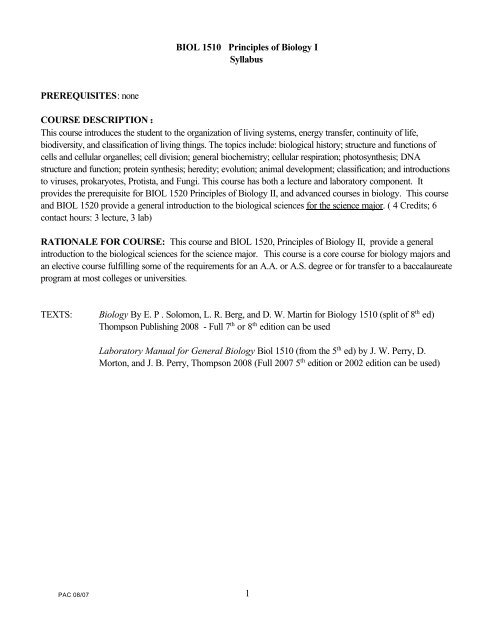
![Fall-Winter 2007 [PDF] - Lakeland Community College Library](https://img.yumpu.com/50477235/1/190x245/fall-winter-2007-pdf-lakeland-community-college-library.jpg?quality=85)
